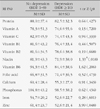Abstract
Purpose
This study was conducted to identify the association of dietary intake levels with ante-natal depression among pregnant women.
Methods
Secondary data analysis was done using Can Pro software (version 3.0) to evaluate the diet intake levels with 24 hour recall diary method with 130 pregnant women visiting a general hospital. Statistical analysis included descriptive statistics, t-test, Mann-Whitney U test and adjusted logistic regression using the SPSS/WIN program.
Results
Whole dietary intake levels of pregnant women were insufficient according to Recommended Nutrient Intake (RI) with the except of phosphorus intake. There were significant differences in RI by gestation period and high risk pregnancies. Non-depressed women showed more intake in niacin (z=1.33, p=.018) and zinc (t=3.99, p=.048) than depressed women did. Niacin was a significant determinant of ante-natal depression (Exp (B)=5.88, p=.47, 95% CI [1.02~23.83]).
Figures and Tables
References
1. Bae H.S. Risk factors affecting the health of pregnant women and fetus. Korean Journal of Community Nutrition. 2008. 13:805–817.
2. Bodnar L.M., Wisner K.L. Nutrition and depression: Implication for improving mental health among childbearing-aged women. Biological Psychiatry. 2005. 58:679–685.
3. DiGirolamo A.M., Ramirez-Zea M. Role of zinc in maternal and child mental health. The American Journal of Clinical Nutrition. 2009. 89:940S–945S.
4. Han Y.S., Lee S.E. Association of nutrient intake and pregnancy outcome with gestational weight gain. Korean Journal of Nutrition. 2010. 43:141–151.
5. Hurley K.M., Caulfield L.E., Sacco L.M., Costigan K.A., Dipietro J.A. Psychological influences in dietary patterns during pregnancy. Journal of the American Dietetic Association. 2005. 105:963–966.
6. Kim H.W. Development of the pregnancy nutrition knowledge scale and its relationship with eating habits in pregnant women visiting community health center. Journal of Korean Academy of Nursing. 2009. 39:33–43.
7. Kim H.W., Kim N.S. Dietary intake level of pregnant women visiting community health center. Kwandong Medical Journal. 2009. 13:29–40.
8. KIm H.W., Jung Y.Y. Influencing factors on antenatal depression. Korean Journal of Women Health Nursing. 2010. 16:95–104.
9. Guide to assessment of vitamins and minerals in health food. Korea Food and Drug Administration. 2007. 2011, July, 30. Retrieved from, http://hfoodi.kfda.go.kr/data/pds_view.jsp?sfield=&skey=null&pageStr=4&intIdx=246&cateIdx=69&categoryCode=18.
10. Kwon M.K. Antenatal depression and mother fetal interaction. Journal of Korean Academy of Child Health Nursing. 2007. 13:416–426.
11. Ladipo O.L. Nutrition in pregnancy: Mineral and vitamin supplements. American Journal of Clinical Nutrition. 2000. 72:280S–290S.
12. Lee Y.H. The relations between attribution style, life events, event attribution, hopeless and depression. 1993. Seoul: Seoul National University;Unpublished doctoral dissertation.
13. Leung B.M.Y., Kaplan B.J. Perinatal depression: Prevalence, risks, and the nutrition link -a review of the literature. Journal of the American Dietetic Association. 2009. 109:1566–1575.
14. Melanson K.J. Nutrition review: Relationships nutrition with depression and anxiety. American Journal of Lifestyle Medicine. 2007. 1:171–174.
15. Miyake Y., Sasaki S., Yokohama T., Tanaka K., Saito K., Fukushima W., et al. Risk of postpartum depression in relation to dietary fish and fat intake in Japan: The Osaka maternal and child health study. Psychological Medicine. 2006. 36:1727–1735.
16. Nowak G., Szewczyk B., Pilc A. Zinc and depression. An update. Pharmacological Reports. 2005. 57:713–718.
17. Vahdat Shariatpanaahi M., Vahdat Shariatpanaahi Z., Moshtaaghi M., Shahbaazi S.H., Abadi A. The relationship between depression and serum ferritin level. European Journal of Clinical Nutrition. 2007. 61:532–535.
18. The Korean Nutrition Society. Can-Pro 3.0: Computer aided nutritional analysis program. 2006. Seoul:
19. Dietary reference intakes for Koreans. The Korean Nutrition Society. 2010. Author, 2011, July, 20. retrieved from http://www.kns.or.kr.




 PDF
PDF ePub
ePub Citation
Citation Print
Print







 XML Download
XML Download